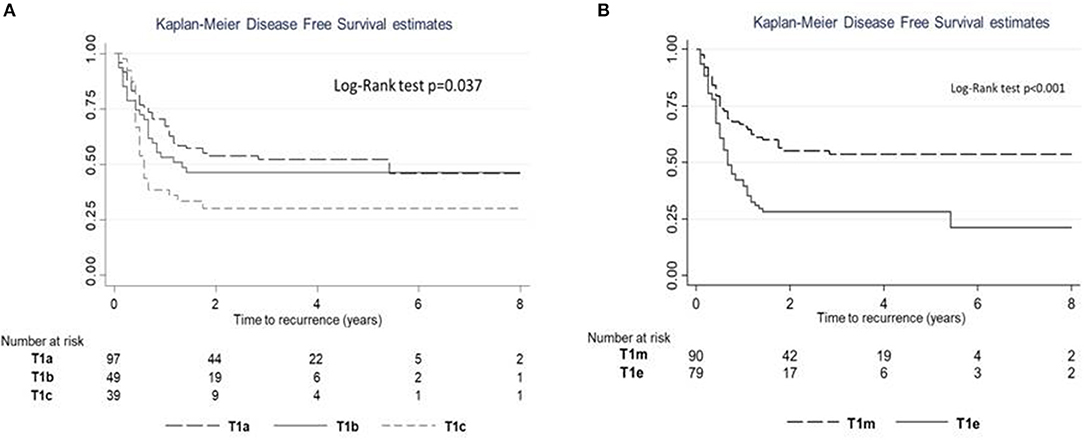Back
Poster, Podium & Video Sessions
Moderated Poster
MP54: Bladder Cancer: Non-invasive II
MP54-12: T1 Bladder Cancer: Comparison of the Prognostic Impact of Two Substaging Systems on Disease Recurrence and Progression and Suggestion of a Novel Nomogram
Monday, May 16, 2022
8:45 AM – 10:00 AM
Location: Room 228
Andrea Fuschi*, Yazan Al Salhi, Alessia Martoccia, Lorenzo Capone, Silvio Scalzo, Paolo Pietro Suraci, Antonio Carbone, Antonio Luigi Pastore, Latina , Italy, Rossana Telesca, Rome , Italy, Gaia Colalillo, Roberto Miano, Enrico Finazzi Agro', Anastasios Asimakopoulos, Rome, Italy
- AF
Poster Presenter(s)
Introduction: The T1 substaging of bladder cancer (BCa) potentially impacts disease progression. The objective of the study was to compare the prognostic accuracy of two substaging systems on the recurrence and progression of primary pathologic T1 (pT1) BCa and to test a nomogram based on pT1 substaging for predicting recurrence-free survival (RFS) and progression-free survival (PFS).
Methods: The medical records of 204 patients affected by pT1 BCa were retrospectively reviewed. Substaging was defined according to the depth of lamina propria invasion in T1a-c and the extension of the lamina propria invasion to T1-microinvasive (T1m) or T1-extensive (T1e). Uni- and multivariable Cox regression models evaluated the independent variables correlated with recurrence and progression. The predictive accuracies of the two substaging systems were compared by Harrell's C index. Multivariate Cox regression models for the RFS and PFS were also depicted by a nomogram.
Results: The 5-year RFS was 47.5% with a significant difference between T1c and T1a (p = 0.02) and between T1e and T1m (p < 0.001). The 5-year PFS was 75.9% with a significant difference between T1c and T1a (p = 0.011) and between T1e and T1m (p < 0.001). Model T1m-e showed a higher predictive power than T1a-c for predicting RFS and PFS. In the univariate and multivariate model subcategory T1e, the diameter, location, and number of tumors were confirmed as factors influencing recurrence and progression after adjusting for the other variables. The nomogram incorporating the T1m-e model showed a satisfactory agreement between model predictions at 5 years and actual observations.
Conclusions: Substaging is significantly associated with RFS and PFS for patients affected by T1 BCa and should be included in innovative prognostic nomograms.
Source of Funding: None


Methods: The medical records of 204 patients affected by pT1 BCa were retrospectively reviewed. Substaging was defined according to the depth of lamina propria invasion in T1a-c and the extension of the lamina propria invasion to T1-microinvasive (T1m) or T1-extensive (T1e). Uni- and multivariable Cox regression models evaluated the independent variables correlated with recurrence and progression. The predictive accuracies of the two substaging systems were compared by Harrell's C index. Multivariate Cox regression models for the RFS and PFS were also depicted by a nomogram.
Results: The 5-year RFS was 47.5% with a significant difference between T1c and T1a (p = 0.02) and between T1e and T1m (p < 0.001). The 5-year PFS was 75.9% with a significant difference between T1c and T1a (p = 0.011) and between T1e and T1m (p < 0.001). Model T1m-e showed a higher predictive power than T1a-c for predicting RFS and PFS. In the univariate and multivariate model subcategory T1e, the diameter, location, and number of tumors were confirmed as factors influencing recurrence and progression after adjusting for the other variables. The nomogram incorporating the T1m-e model showed a satisfactory agreement between model predictions at 5 years and actual observations.
Conclusions: Substaging is significantly associated with RFS and PFS for patients affected by T1 BCa and should be included in innovative prognostic nomograms.
Source of Funding: None



.jpg)
.jpg)